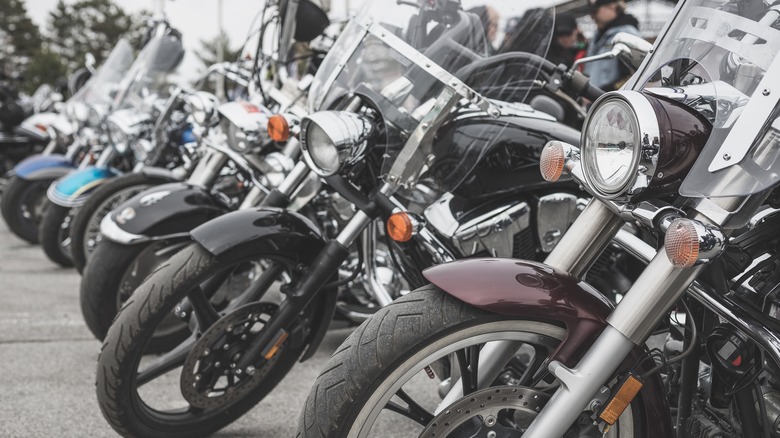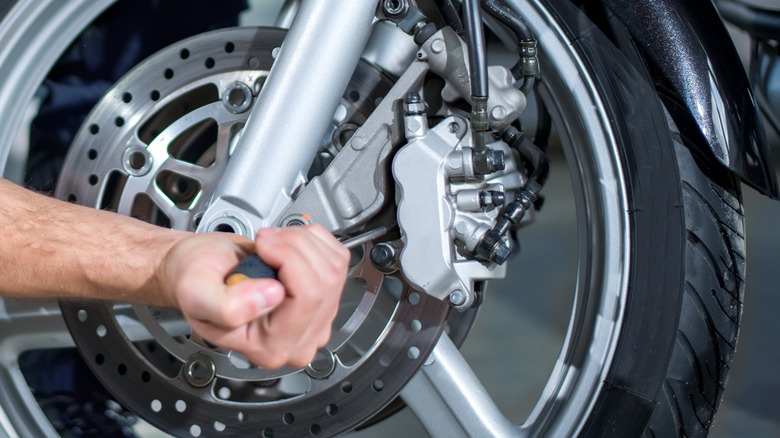Everything You Need To Know Before Buying A Used Motorcycle
From our office cubicles to our houses, many of us are trapped in boxes of different sizes for most days. It's no wonder that many people are craving the feeling of adventure and life on the road. Unfortunately, rising gas prices and automobile maintenance fees make it difficult to make the dream road trip happen. Thankfully, there's another way to do it with motorcycles. With its relatively lighter frame, lower operating costs, and ability to get into tight spaces that cars can't, it's a perfect riding companion for people looking to taste some freedom on the road.
But even if there are some pretty affordable motorcycles in the market, you may not be ready to commit to a brand-new one just yet. For example, you may not be sold yet on the motorcycle riding life or want to practice with a safer model before going all-out. To lessen the risk of buying something that you may end up not using, you may want to try your luck with trying out a used motorcycle instead.
As with any type of vehicle, there's always a lot of uncertainty when buying second-hand. However, if done right, you can save a lot of time and money. For the environmentally conscious, it may even lessen your carbon footprint in the process. So, whether you're a first-time buyer or a seasoned motorcycle rider with thousands of miles under your belt, here is everything you need to know before buying a used motorcycle.
Define your needs and budget
Similar to buying a car, one of the first things you need to consider before buying a second-hand motorcycle is if it fits with your lifestyle. For it not to be a liability, it has to be clear to you what objective you have with adding a motorcycle to your garage. First, you have to decide if your motorcycle is meant to supplement your other vehicles, your existing lifestyle, or enable you to try new things. Then, you can decide what its primary purpose is, such as commuting, touring, or off-roading.
Afterward, depending on how often you plan to use it, you can craft a budget. Although motorcycles are generally more affordable than cars, motorcycle riders who are fully committed to the lifestyle will be happy to know that several high-end motorcycles also combine performance and luxurious designs.
If you're a first-time motorcycle driver, you will want to include additional costs for first-time ownership as well. Aside from the motorcycle itself, you should factor in the cost of additional gear. From choosing a sturdy helmet to finding the right motorcycle jacket, dressing the part can lead to a safer and overall more enjoyable riding experience.
Lastly, you need to factor in the cost of insurance. If your motorcycle is stolen, comprehensive insurance will help make sure you're covered. If law enforcement can find it, you may still be able to utilize your insurance to pay for any repairs.
Research models and check reviews
Once you identify what your motorcycle needs are, you can go deeper into your preferred motorcycle types, whether it is adventure and touring bikes, sport bikes, cruisers, or off-road bikes. If you value sustainability, you can even opt for an electric motorcycle. However, bear in mind it will be more expensive than gas and come with a lot of other caveats, such as reduced range and heaviness.
If you're a very price-conscious individual, opting for motorcycle brands with the lowest maintenance costs can definitely make a difference in your overall cost of ownership. Some companies like Honda have proven their reliability and durability throughout the years.
With comfort and ergonomics affecting everything from your motorcycle riding experience to overall safety, finding the right fit for your height can make all the difference. Thankfully, there are plenty of motorcycle options for tall and short riders alike. Unlike cars, motorcycles don't give riders a protective cage and deploy airbags in case of a crash. However, some motorcycle brands like Ducati have been prototyping new types of technology to help prevent accidents from occurring.
After you've narrowed down your ideal brands and models, you can proceed to check their reviews on online forums. Then, you can search for this particular model in dealerships, online marketplaces, or classified ads. When possible, try to verify reviews of the seller as well. On some platforms, there are sell ratings, which you can use to weed out potential scammers.
Do a visual workaround
When meeting the seller to test the motorcycle, make sure to prioritize your own safety by only meeting in public places, during the day, and in a well-lit area. Once you're in a comfortable and safe place, you can proceed to verify for yourself how well-maintained the motorcycle you're planning to purchase is.
To start with, Motorcycle Habit recommends paying attention to how it looks with a visual look around. For example, scrapes at the engine or engine covers may indicate that the motorcycle has been dropped previously. Aside from this, you can look out for other signs of damage like rust or welding.
Next, you should pay attention to its essential fluids: engine oil, brake fluid, transmission oil, coolant, fork oil, and hydraulic clutch, according to Valvoline. When testing for oil levels, Castrol recommends making sure to park your bike on level ground, which you can do using a center stand, paddock, or even an aluminum can. Then, wait for the engine to cool and the oil to return to the pump, and use a dipstick to check the level.
Afterward, you should check the condition of the oil, such as the color and viscosity. Oil should be green or yellow, glossy, and semi-transparent. If you find any thick sludge or metal particles or if the oil is black, the motorcycle may need an oil change before you can take it for a test ride.
Go for a test ride
Should your initial assessment be positive and you're comfortable riding the motorcycle, you can proceed to do a test lap or two. However, it's always a good idea to proceed with caution and drive slowly to test the brake pads before going all-in to avoid potential accidents.
Afterward, you can check how smooth the ride is, which will reveal its suspension health. Pay attention to the tension on its chain and for any weird sounds coming from the engine. While you could easily replace its tires, it's also good to know what you're working with and if you'll need to factor in the cost of replacing it in your overall purchase price.
If the seller is amenable, you can even request a pre or post-purchase inspection done by a mechanic so you can have a professional opinion. With this, they may be able to spot issues that you were not able to during your own inspection.
Before signing any documents, make sure to take pictures and videos of the motorcycle from all angles during your inspections. If, during the process of transferring ownership, any contentions on the condition of the motorcycle happen, such as the swapping out parts before it is turned over, you'll have full documentation to back up your claims. Once you decide that you've found the perfect second-hand motorcycle, make sure that you properly load your motorcycle onto a trailer if you're not going to ride it home yet.
Transfer ownership the right way
In most states, motorcycle owners must have a title and appropriate registration documents. Aside from this, it is recommended to have a notarized Bill of Sale so the owner can't go back on their terms in the middle of your transaction, adding a layer of protection against scammers.
According to the California Department of Motor Vehicles (DMV), you'll need to update the DMV records within 10 days once a vehicle or vessel has a change of ownership and start the process to transfer the California Certificate of Title. When buying a motorcycle from a dealership, it will typically handle the paperwork on your behalf and simply email your title via mail. However, when buying from another person, the seller will need to provide the California Certificate of Title.
If they can't provide this, you'll need to prepare an Application for Replacement or Transfer of Title, the seller's signature, the buyer's signature, and a transfer fee. The DMV states that you may need to submit additional forms depending on your transfer fee, which you can calculate via its DMV Fee Calculator.
Once the buyer provides all the necessary documentation and fees, the DMV headquarters should issue the new title within 60 days. If you're not sure what kind of requirements you'll need for your particular second-hand motorcycle purchase, you can check with its previous owner or your local DMV office for more information.
Buy a used motorcycle safely
For some people, buying second-hand can feel very risky. Although it's not impossible to be scammed, it's important to understand that people let go of their motorcycles for many reasons and not just because they're already rundown or broken. For example, they may be adding new family members and require a vehicle that can handle more people. Some people may be upgrading to a motorcycle more suited to their lifestyle. Or, some motorcycle riders may have just decided that they prefer to drive cars instead.
Regardless of the reason, there are many well-maintained second-hand motorcycles that you can get your hands on if you know where to look. Additionally, it's best to cover all your bases, including requesting the necessary documentation, getting a professional opinion, and using a secure payment platform.
If you're a beginner, make sure to get the motorcycle operator's license or an endorsement on your current license. Typically, this will require a written test and riding test, where you can demonstrate your riding abilities. While motorcycle licenses vary from state to state, completing a Motorcycle Safety Foundation (MSF) Basic RiderCourse may waive the road test.
By following the tips above, you can prevent impulsive purchases and have a more methodological way to determine whether a second-hand motorcycle really is for you. If not, you may want to consider waiting a bit longer for a better deal or getting a brand-new one instead.






